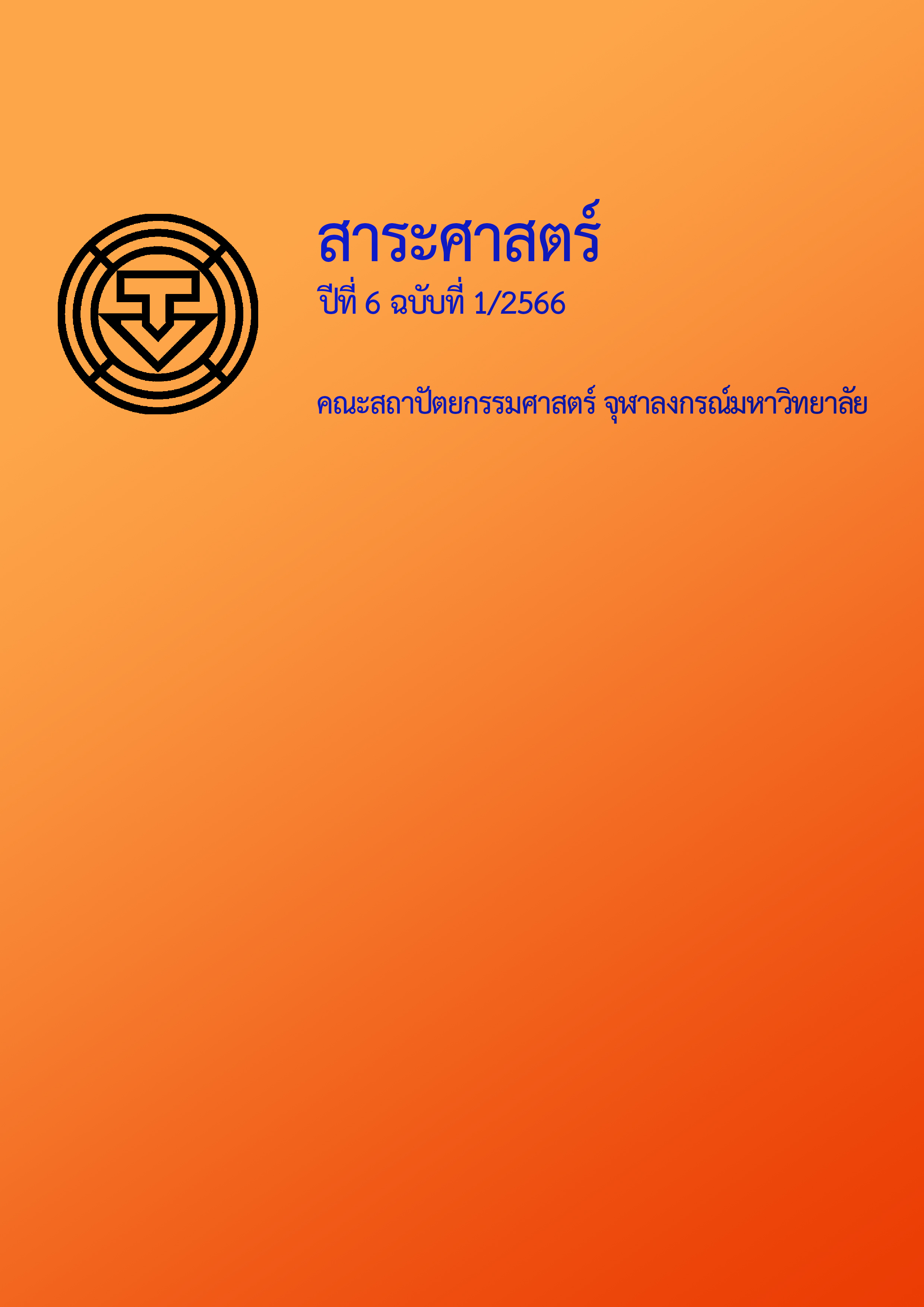Energy Performance and Thermal Comfort of Displacement Ventilation Cooling Using Fanless Split Air-conditioner
Main Article Content
Abstract
The purposes of this research aimed to evaluate the comfort efficiency and study the energy saving efficiency of the prototype air conditioner. The fanless split air conditioner was examined in a simulation room with a size of 1.60 x 2.70 x 2.60 m. by using lamps of 5W, 10W and 15W respectively to add the variables. In such room, a 12-channel thermometer was installed accompanied by a dry-wet bulb temperature, a power recorder meter and a dehumidifier. The length of the research was short, conducted in November, 2022, (the beginning of winter) based on an examination period of 24 hours of 1 day under the room temperature of Khon Kaen Province. According to the result, it was found that the air conditioning system continued operating without system shutdown or restarting for a minimum of 24 hours. The results also showed that the average temperature gradually decreased every 2 hours, and the air cooling is evenly distributed as the air conditioner was operating continuously over 6 hours. Nonetheless, it was notable that the relative humidity was rarely different from the prior experiments. As per the evaluation of comfort efficiency, it was found that the temperature throughout the experiment was within the comfort standard of Thai people (temperatures of 27.5 - 28.53 degrees Celsius), and a relative humidity of not over 70%. In conclusion, the energy saving of this air conditioner was 26.5% and increase in comfort of 8.164%, with an average temperature of 26°C and a relative humidity of 64.5%RH. Considered more efficient than the conventional air conditioners, but its humidity is also a significant factor worth noting. Dehumidification guidelines should be developed and further improved for the enhanced performance to achieve higher efficiency, be able to use the fanless split air conditioner with its full capacity and develop the split-type air conditioners for household uses to save more energy.
Article Details
References
กรมพัฒนาพลังงานทดแทนและอนุรักษ์พลังงาน. (2547). ตําราฝึกอบรมหลักสูตรผู้รับผิดชอบด้านพลังงาน (ผชพ.) สามัญ. http://www2.dede.go.th/bhrd/old/file_handbook.html
กระทรวงพลังงาน. สำนักงานนโยบายและแผนพลังงาน. (2564). รายงานสถิติพลังงานของประเทศไทย. https://www.dede.go.th/download/stat63/12_SIT_Jan-Dec%2064_01.pdf
กลุ่มสถิติและข้อมูลพลังงาน. (2563). สถานการณ์พลังงานของประเทศไทย (มกราคม-ธันวาคม 2564). https://www.dede.go.th/ewt_news.php?nid=47349
คู่มือผู้รับผิดชอบด้านพลังงาน. (2561). การอนุรักษ์พลังงานในระบบไฟฟ้าแสงสว่าง. https://image.makewebeasy.net/makeweb/0/mqk9PemK3/Document/Part_2_Chapter_3_%E0%B8%9B%E0%B8%B5_2561.pdf?v=202012190947
ดลสิทธิ์ แทนคำ, ชลสิทธิ์ เหล่าสนธิ์, และภุชงค์ จันทร์จิระ. (2564, กรกฎาคม-ธันวาคม). การประหยัดพลังงานไฟฟ้าของเครื่องปรับอากาศด้วยอุปกรณ์ระบายความร้อนจากน้ำทิ้งของพัดลมคอยล์เย็น. วารสารวิชาการอุตสาหกรรมศึกษา มหาวิทยาลัยศรีนครินทวิโรฒ, 15(2), 10-23.
ดาวรุ่งรตา วงษ์ไกร. (2563, พฤษภาคม-สิงหาคม). ปัจจัยทางการจัดการการตลาดที่มีอิทธิพลต่อพฤติกรรมการตัดสินใจซื้อเครื่องปรับอากาศเพื่อที่อยู่อาศัยของผู้บริโภคในอำเภอลำลูกกา จังหวัดปทุมธานี. วารสารวิจัยมหาวิทยาลัยเวสเทิร์น มนุษยศาสตร์และสังคมศาสตร์, 6(2), 82-93.
ทรงพล โพธิ์สุวัฒนากุล. (2552). ประสิทธิภาพการใช้พลังงานรวม (IEER) สำหรับเครื่องปรับอากาศแบบแยกส่วนขนาดเล็ก [วิทยานิพนธ์ปริญญามหาบัณฑิต ไม่ได้ตีพิมพ์]. จุฬาลงกรณ์มหาวิทยาลัย.
เทรน ประเทศไทย. (2556). คู่มือการติดตั้งเครื่องปรับอากาศ. http://www.tranethailand.com/data/product/ adfiopruv178.pdf
นพรัตน์ เกตุขาว และสิทธิพร ศรีเมือง. (2561). SEER คืออะไร. http://www.me.eng.up.ac.th/index.php/ 2017-11-22-08-53-08/19-seer
นิกร เนื่องอุตม์, ปิยากร จันทะนะ, สมนึก เครือสอน, และณรงค์ฤทธิ์ พิมพ์คำวงศ์. (2559). การเพิ่มประสิทธิภาพเครื่องปรับอากาศแบบแยกส่วนโดยใช้ลมเย็นจากพัดลมระบายอากาศ. วารสารวิชาการและวิจัย มทร.พระนคร, 10(1), 15-23.
นิรันดร์ วัชโรดม. (2561). การเพิ่มสัมประสิทธิ์สมรรถนะของระบบปรับอากาศแบบแยกส่วน โดยอาศัยพลังงานความร้อนทิ้งกลับมาใช้ใหม่. วารสารวิชาการ มทร. สุวรรณภูมิ, 6(2), 134-147.
นินนาท ราชดิษฐ์, จุฑาวัชร สุวรรณภพ, และ นฤพล สร้อยวัน. (2556). การศึกษาผลกระทบของรูปแบบการระบายอากาศที่มีต่อระดับความชื้นสัมพัทธ์ภายในสำนักงานที่ใช้เครื่องปรับอากาศแบบแยกส่วน. วารสารมหาวิทยาลัยนเรศวร, ฉบับพิเศษ, 17-23.
มานพ แจ่มกระจ่าง. (2549, มิถุนายน-ตุลาคม). ศึกษาทางเลือกการตั้งอุณหภูมิเครื่องปรับอากาศที่เหมาะสมเพื่อการประหยัดพลังงาน. วารสารศึกษาศาสตร์มหาวิทยาลัยบูรพา, 18(1), 77-78.
สกลทรรศน์ อินแก้ว, นพดล อำภา, และปฐวี ถือแก้ว. (2557). การเพิ่มประสิทธิภาพพลังงานของเครื่องปรับอากาศแบบแยกส่วนด้วยชุดสายยางน้ำซึม [วิทยานิพนธ์ปริญญาบัณฑิต ไม่ได้ตีพิมพ์]. มหาวิทยาลัยนเรศวร.
สมาคมวิศวกรรมปรับอากาศแห่งประเทศไทย. (2556). มาตรฐานการติดตั้งเครื่องปรับอากาศแบบแยกส่วน. https://www.ashraethailand.org/download/ashraethailand_org/Standard_update%2028%20April%202015.pdf
Alamdari, F. D., Butler, J. G., Grigg, P. F., & Shaw, M. R. (1998). Chilled ceilings and displacement ventilation. Renewable Energy, 15(1–4), 300-305.
American Society of Heating, Refrigerating and Air Conditioning Engineers. (2009). ANSI/ASHRAE 138-2009: Method of testing for rating ceiling panels for sensible heating and cooling. ASHRAE. https://webstore.ansi.org/preview-pages/ASHRAE/preview_ANSI+ASHRAE+Standard+138-2009.pdf
American Society of Heating, Refrigerating, and Air Conditioning Engineers. (2016). ASHRAE handbook-HVAC systems and equipment. ASHRAE. http://arcohvac.ir/wpcontent/uploads/2016/11/ASHRAE-Handbook-2016-HVAC-Systems-and-EquipmentIP.pdf
Feng, Yang, Feng, Qian, & Stephen, S. Y. Lau. (2013). Urban form and density as indicators for summertime outdoor ventilation potential: A case study on high-rise housing in Shanghai. Building and Environment, 70, 122-137.
Guohui, Gan, & Riffat, Saffa B. (2004). CFD modelling of air flow and thermal performance of an atrium integrated with photovoltaics. Building and Environment, 39(7), 735-748.
Lee, Haw- Long, Chou, Huann- Ming, & Yang, Yu- Ching. (2004). The function estimation in predicting heat flux of pin fins with variable heat transfer coefficients. Energy Conversion and Management, 45(11-12), 1749-1758.
Skistad, H. (n.d.). Displacement ventilation research studies press, thermal environmental conditions for human occupancy. https://www.ashrae.org/File%20Library/Technical%20Resources/Standards%20and%20Guidelines/Standards%20Addenda/55_2010_i_k_l_m_n_r_Final_07092013.pdf
Halton. (n.d.). Displacement ventilation design guide. https://www.yumpu.com/en/document/read/31498004/displacement-ventilation-design-guide-halton
ISO 11855-2:2012(E). (n.d.). Building environment design-Design, dimensioning, instalation and control of embedded radiant heating and cooling systems. https://www.iso.org/standard/52408.html
The Japan Society of Refrigerating and Air Conditioning Engineers (JSRAE) of Japan. (n.d.). Report “risk assessment of mildly flammable refrigerants.” http://aradtahvieh.ir/wp-content/uploads/2016/05/ASHRAE-2012.pdf
Khedari, Joseph, Yamtraipat, Nuparb, Pratintong, Naris, & Hirunlabh, Jongjit. (2000). Thailand ventilation comfort chart. Energy and Buildings, 32, 3245-249.
Rhee, Kyu-Nam, Olesen, Bjarne W., & Kim, Kwang Woo. (2017). Ten questions about radiant heating and cooling systems. Building and Environment, 112, 367-381.
Liu, Sheng-Chun, Yi-Tai, & Wei, Lu. (2021). Analysis about EER and SEER of air conditioner. Journal of Tianjin University Science and Technology, 39, 1088-1092.
Djongyang, Noël, Tchindac, René, & Njomoa, Donatien. (2010). Thermal comfort: A review paper. Renewable and Sustainable Energy Reviews, 14, 92626-2640.
Olgyay, V. (1963). Design with climate. Princeton University Press.
Persily, A. K. (1997). Evaluating building IAQ and ventilation with indoor carbon dioxide.0. ASHRAE Transactions, (103), 2193-2204.
Riffat, S. B., Zhao, X., & Doherty, P. S. (2004). Review of research into and application of chilled ceilings and displacement ventilation systems in Europe. International Journal of Energy Research, 28, 257–286.
Simmonds, P., Mehlornakulu, B., Chambers, I., & Simmomds, C. (2006, January). Applied performance of radiant ceiling panels for cooling. ASHRAE Transactions, (112), 368-376.
Yuan, Xiaoxiong, Che, Qingyan, & Glicksman, Leon R. (2010). A critical review of displacement ventilation. https://www.aivc.org/sites/default/files/airbase_11091.pdf


